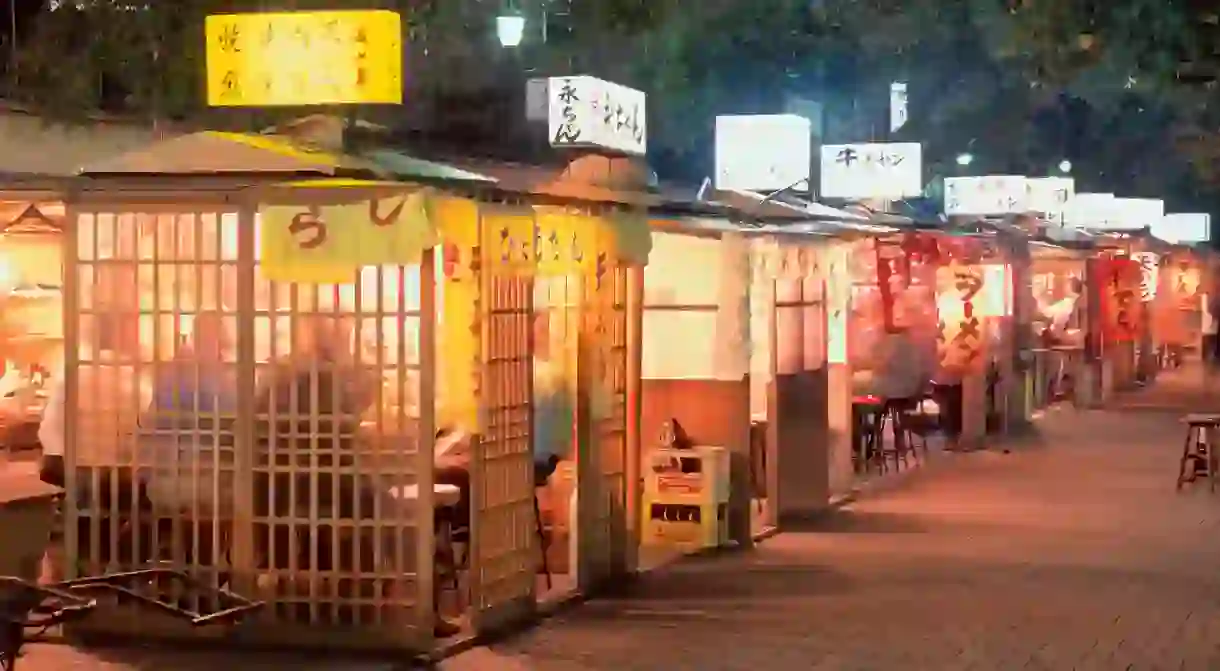A Guide to Fukuoka's Fabled Yatai

Fukuoka might not boast Tokyo’s dazzling lights, Kyoto’s time-worn temples or Mount Fuji’s postcard vistas. What it can claim, however, is a breezy coastal atmosphere that comes alive at sunset, when the city’s dozens of yatai food stands start sizzling.
While these open-air market stalls used to be popular across Japan, they’ve disappeared pretty much everywhere except Fukuoka, making them one of Kyūshū’s most unique cultural drawcards. Barbecued yakitori, golden gyoza, steaming ramen… sure, this isn’t fine dining, but the laid-back atmosphere is all part of the charm. From the Nakasu Island waterfront to the city streets of Tenjin, read on for everything first-timers need to know about chewing their way through Fukuoka’s fabled food stalls.
What are yatai?

Yatai — literally ‘shop stand’ in Japanese – boomed in the late-1800s, when these two-wheeled wooden carts multiplied across the country. And while they fell out of favour as the rest of Japan modernised, they remained a firm Fukuoka favourite. Numbers may have dwindled since their heyday – Fukuoka once housed almost 500 yatai, and only has a little over 100 today — but the concept remains a cherished tradition. In fact, stall-holders must hand their business down to a relative upon retirement otherwise the city tears up the licence.
Yatai themselves are tiny market stands decorated with colourful drapes, lit by warm red paper lanterns, and contained by plastic sheets keeping the warm air in. Most have room for about eight to 10 diners, all squished in shoulder-to-shoulder. With chatty chefs and such close proximity, the stalls are fertile soil for banter with new friends.

Most open at 6pm and keep humming until 2am, barring bad weather or a day off – many stands are closed on Sundays, but hungry travellers can find somewhere to eat seven days a week. Friday and Saturday are the busiest days when diners may have to wait for a seat – naturally, few yatai take reservations, so pounce on any empty seat and prepare to queue if you’re dead keen on a full food stall.
What to eat at yatai?

Each stand specialises in one thing or another: yakitori (grilled chicken skewers, and other meats too), oden (vegetable hot pot), gyoza (dumplings), udon (noodles), tempura, mentaiko (spicy pollock roe), takoyaki (battered octupus balls), the list goes on. The top local specialty, though, is Hakata reman – thin noodles in a rich pork bone broth named after the ancient half of the city that now forms half of modern Fukuoka. One thing no stall serves? Raw food. The law says dishes must be hot, so there’s no sashimi or raw vegetables – instead, just piping-hot street snacks.
Many yatai – particularly in more touristy areas – have multilingual menus to explain their delicacies, displaying prices on the outside of their stall. First-timers should check if there’s an otoshi (surcharge for appetisers) or minimum order, available payment methods (card, cash, or a combo of both), and particularly prices – most dishes are around ¥500-1000 (£3.85-7.70), and diners usually order a handful over the course of an evening.

Yatai serve alcoholic drinks: beer, local Kyūshū sake and shochu (distilled from rice), or the ever-popular highball – sparkling water with whisky in a tall glass. But the etiquette is to move on after half-an-hour or so to make room for someone else rather than clinging to a stool all night boozing, while taking a tipple away from a yatai is uncouth. And don’t worry, there are public toilets dotted around the major streets – just ask the stall-holder for their nearest loo.
Where to find yatai?

There’s a little over 100 yatai sprinkled across Fukuoka, and they’re concentrated chiefly around two main areas. The first is the Nakasu nightlife precinct – an island in the heart of the city, sandwiched between the Naka and Hakata Rivers. A row of 20-odd yatai hug the south-western edge of Nakasu with the water as their sparkling backdrop.
The other is Tenjin, Fukuoka’s commercial district just west of Nakasu. Follow Showa-dori – itself lined with yatai on the island – to the Tenjin Building and Tenjin station, then hook a left to Kego Park. This area showcases dozens of old-school favourites, and it’s where diners might have to wait for a spot at a table they’re desperate to sink their teeth into on a busy Friday or Saturday night.

Watanabe-dori stretching south of Tenjin hosts more modern yatai stands – the city handed out 14 new licences in 2019, for instance. Covering the stretch between Kego Park on Tenjin Chikagai, the stalls on this street down to Watanabe-dori station are spaced a little further apart. That said, the trio of stalls in front of the Loft supermarket – Telas&mico, Jonetsu no chidoriashi and Chez Remy – earn rave reviews.
One of Fukuoka’s great charms is strolling the streets on a balmy evening to sniff out street stalls, which appear almost everywhere in the city centre. There’s a pair tucked behind the Canal City Hakata mall across the road from the Mangyo-ji temple, two at the Kego Crossing in the south of the city, and a couple just east of Hakata station. And don’t miss the four outside Fukuoka’s legendary fish market, sampling the city’s ocean-fresh seafood virtually direct from the source.













